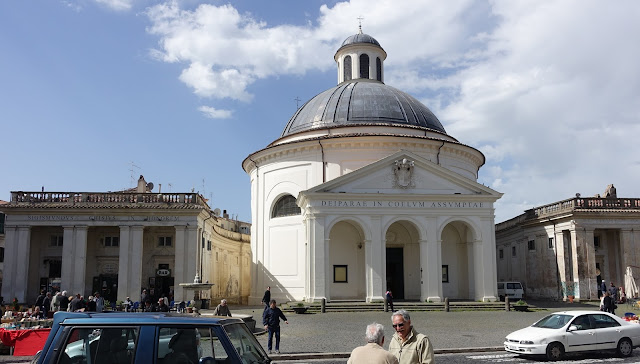You can't. Walk in Rome safely, that is. But there are some things you can do, and information you need to have, to improve the odds of your staying alive in the Eternal City.
| Parked in a crosswalk |
And of course, sometimes vehicles park in the crosswalk. Worse still, in the Flaminio piazza where we lived, vehicles--cars, trucks, scooters (we do it, too)--routinely use the crosswalk to make u-turns up the adjacent street. Keep you eyes peeled.
2. Even when crossing at lights there are hazards. Cars seldom go through red lights, but about 1 in 10 scooters pay little attention to the color of the light. Often scooters will approach a red light, slow down, then accelerate through it. Moreover, traffic in Rome is such that when the light turns green, vehicles--especially scooters--move away rapidly. Therefore, be sure you have plenty of time to get across the intersection; don't get caught in the street when the light changes. In the words of a 1970s blues tune, "stop on the red, go on the green, don't get caught by Mr. Inbetween."
3. Understand that Rome motorists are distracted in a way they were not only a few years ago. Today, many motorists and scooter drivers are listening to music, on the phone with a spouse or lover (maybe having an argument), or otherwise not paying full attention to the road. Some of those driving scooters will check their cell phones, and even text, while they're in motion (it is possible, though ill-advised, to drive a scooter with only the right hand, which covers the accelerator and one brake). Not long ago, on the fastmoving Muro Torto, a woman on a scooter, on the phone (tucked into her helmet) was driving with the right hand while gesturing dramatically with the left.
4. Watch out for Smart Cars. Rome's Smart Car population is growing rapidly. Two problems arise. First, Smart Car drivers are among the most distracted in the city. Why? Because, unlike most automobiles in Rome, Smart Cars shift automatically. Hence drivers do not have to use two hands, leaving one free to a) smoke b) eat c) use a cell phone d) gesture. Second, Smart Car drivers, feeling liberated from the big cars they used to drive (and that had trouble navigating traffic), now act like scooter drivers, weaving in and out of traffic, often dangerously. But they're not scooters. They can't turn as easily as scooters or stop as fast as scooters. It won't take long for Smart Car drivers to learn they're not scooters, but as for now the lesson hasn't sunk in.
5. Scooter drivers vary in their behaviors. Some will brake for pedestrians (no matter where they are), others will swerve to avoid them without stopping, and still others will avoid them, but barely--as if the pedestrians were cones in game of skill. So beware. Most scooters, thank God, can stop on a dime. But--this is really important--scooter drivers may be on the phone or listening to a favorite tune and hence somewhat distracted. Even so, driving a two-wheeled vehicle without falling requires having eyes on the road at all times. You can pretty much guarantee that a scooter driver will see you in the crosswalk and will be thinking about whether to stop or how to avoid you. Not so with cars.
6. There is no right on red in Rome, and it's uncommon. But some do it, anyway.
7. "You can walk but they can kill you." That's been our motto the past few years. Unlike in the States, where a pedestrian walk light indicates that pedestrians can expect the intersection to be clear of vehicles, in Rome a pedestrian walk light is often coupled with a green arrow for vehicles that signals the right to move through the area you';re about to walk in. If that seems crazy or wrong, get used to it. To be safe, expect it, especially at complex intersections.
| "You can walk but they can kill you." Crosswalk, pedestrian OK, but cars turning right over the crosswalk, in front of you. That's Monte Mario in the background. |
| Heavy traffic? Scooters now and then use the sidewalk. |
9. Sidewalks normally provide protection against getting run over. But scooters often park on the sidewalk, and to get there they drive ON the sidewalk, sometimes for most of a block. If traffic is very heavy, scooters may use the sidewalk as if it were another lane. Be aware.
10. While crossing one-way streets, look both ways. Rome isn't London, where driving the wrong way on a one-way street would earn a quick ticket. Scooters, especially (including this driver) will sometimes go the wrong way to find a parking space--or whatever. Be conscious.
Bill
For more on scooters, see our posts on renting a scooter in Rome, riding a scooter in Rome, parking a scooter in Rome, getting a ticket in Rome, preventing scooter thefts, and junking a scooter in Rome.







